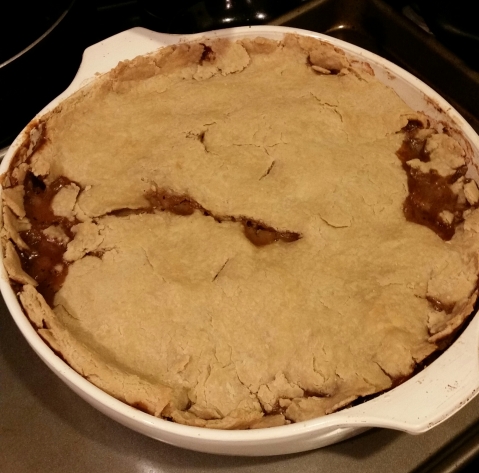One of the challenges of making a monthly pie is that is it very easy to fall behind, especially as the holidays approach. We usually stay on schedule, but occasionally we use a savory pie recipe as a chance to get caught up if we’re off schedule.
This was the hot water crust that topped our last pot pie. It just appeared in the Chicago Tribune on November 2, 2016.
http://www.chicagotribune.com/dining/foodfocus/sc-food-1028-savory-pies-20161026-story.html
Hot water pastry
Prep: 30 minutes
Cook: 5 minutes, plus baking time
Makes: Enough for a double-crust pie
2 cups flour, plus a little extra for dusting
1 pinch of salt
1/4 cup water, or 2 tablespoons water and 2 tablespoons whole milk
6 tablespoons (3 ounces) butter, lard or shortening
Glaze:
1 large egg yolk, beaten
1. In a large bowl, combine the flour and salt; whisk until well-combined. Set aside.
2. Place water and butter or lard into a small saucepan over medium-low heat. Cook until the fat has melted; turn heat to medium-high and bring just to the boil.
3. Immediately pour the fat-water mixture over the flour mixture and stir until a soft, pliable dough forms. Tip the dough out onto a counter dusted with flour and, while the dough is still hot, knead it lightly and quickly. It’s OK if you can only work the dough for a moment at a time but this dough becomes harder to work with as it cools.
4. Pinch off about a quarter of the dough, pat it into a disk and set it aside, covered with plastic wrap. This will be the lid.
5. Roll the rest of the dough into a flattened disk and use it to line an 8-inch springform pan, using your hands to work the dough up the sides as high as the top of the pan. Place your filling into the pastry, then quickly roll out the disk you set aside for the lid into a disk big enough to seal the filled pie. Place lid atop filled pie; crimp edges to seal well. Make a hole in the center of the lid to vent steam and brush the lid with the beaten egg yolk.
6. Bake the filled pie at 350 degrees for 1 to 1 1/2 hours, or until golden brown. Remove the filled pie from the oven and cool completely at room temperature. If the recipe you’re following requires it, when the pie is fully cooled, pour the gelatin through the vent, little by little, to fill in any gaps where the filling shrank from the crust in baking. Refrigerate the pie overnight, and serve chilled.
Nutrition information per serving (for 6 servings): 248 calories, 13 g fat, 7 g saturated fat, 61 mg cholesterol, 29 g carbohydrates, 0 g sugar, 4 g protein, 28 mg sodium, 1 g fiber
This dough was awful to work with. It immediately became tough and crumbly as I rolled it out. I didn’t worry since the I’ve patched pie dough before and it isn’t that noticeable. There were modifications I had to make based on the pie filling itself (post coming soon). There was no chance that our pie was going to fit in an 8-inch springform pan. The idea of a bottom crust was cast aside; the entire portion of the dough became a top crust. Our filling was ready, so there was no need to cover the dough while we finished prepping. It did transfer relatively easily from the rolling surface to the casserole dish, where we had to do a little more patching before the pie went in the oven. The breaking as we tried to tuck the crust under the edges was ridiculous; you can see it in the picture below. We didn’t bother with the egg wash.

Verdict: There’s a reason pie crust comes together with cold water: the butter remains solid, creating pillows of flakiness to melt in your mouth. This crust was not a pleasant eating experience. It tasted as tough and dry as it looked, and needed more than a pinch of salt. I have used a crust recipe where the butter was left cold during mixing but the 1 or 2 tablespoons of water added at the end was hot. That crust was much better. If I made this crust again, I would leave the butter alone and add the hot water at the end. Oddly, there is no need to wrap and chill that crust; the hot water makes the dough pliable enough to roll immediately. Lesson learned: trust the experts and don’t mess with years of baking wisdom.